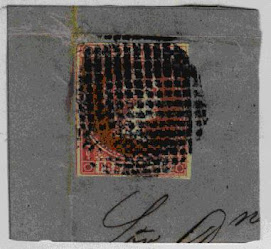The Philippines was the first country in Asia to issue postage stamps. the first set of 4 stamps were issued on February 1, 1854. It resulted from a Royal Decree of Queen Isabella II, issued in Madrid, Spain, dated January 12, 1853 and acted upon in Manila by Captain General Antonio Orbiztondo on December 7, 1853. The Decree instructed the Captain General to print and put on sale stamps for use within the Philippines. The designs copied that which were issued in Spain in 1853 showing the bust of Queen Isabella II, with changes in the year (reading "1854 y 1855" and the currency values (20 cuartos equal to 1 real de plata).
The stamps were intended for interior use only. They were engraved in Manila in plates of 40 subjects (5 X 8), producing 40 different types. They were printed by Plana, Jorba y Lia, Plaza de Binondo, Manila and issued imperforate.
The 5-cuartos stamps were for mails under half-an-ounce (single weight interior rate). Only 1 plate was used, but it underwent several retouchings and re-engravings during printing. 5,000 stamps were printed in shades of orange, brown-orange and red-orange.
The 10-cuartos stamps were for mails between half-an-ounce and one ounce (double interior postage rate). Three plates were used to print this value. A total of 5,000 stamps were printed in shades of carmine, crimson and rose. A 10-cuartos stamp in black was printed also, but was never issued.
The 1-real stamps were for mails between one ounce and one-and-a-half ounces (extra 10-cuartos fee for every half ounce or part of half ounce thereafter). Some say 2,000were issued while others reported it to be 3,000 stamps, in shades of blue and ultramarine. On position 26 of each sheet is the much-sought-after error, wherein "CORREOS" was misspelled "CORROS".
The 2-reales de plata stamp was for registration fee. Quantity issued also differ, either 2,000 or 3,000, in shades of green, emerald-green and yellow green.
It is believed that there were second printings of all values, most probably from redrawn or re-touched plates. On these issues the groundwork around the Quen's head consists of much coarser lines, contrasting wth the lighter, finer linework on the original printing.
150th Anniversary of First Philippine Stamps
Designs:
1) 5 cuartos stamps of 1854 and 150th anniversary logo
2) 10 cuartos stamps of 1854 and 150th anniversary logo
3) 1 real stamp of 1854 and 150th anniversary logo stamp
4) 2 reales stamp of 1854 and 150th anniversary logo

Souvenir sheet: Set of 4 stamps; bottom margin shows the unissued 10-cuartos black stamp and the 1-real "CORROS" error stamp





 Philippines Scott Nos. 14 and 15
Philippines Scott Nos. 14 and 15
 Philippines Scott #20a
Philippines Scott #20a
 Spanish-Philippine Stamp Isabella II on piece
Spanish-Philippine Stamp Isabella II on piece



